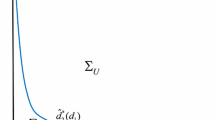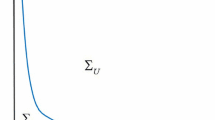Abstract
In this paper, we consider the following Lotka–Volterra competition system with dynamical resources and density-dependent diffusion

in a bounded smooth domain \(\Omega \subset {{\mathbb {R}}^2}\) with homogeneous Neumann boundary conditions, where the parameters \(\mu \), \(a_{i}\), \(b_{i}\), \( c_{i}\) (\(i=1,2\)) are positive constants, m(x) is the prey’s resource, and the dispersal rate function \(d_{i}(w)\) satisfies the the following hypothesis:
-
\(d_{i}(w)\in C^2([0,\infty ))\), \(d_{i}'(w)\le 0\) on \([0,\infty )\) and \(d(w)>0\).
When m(x) is constant, we show that the system (*) with has a unique global classical solution when the initial datum is in functional space \(W^{1,p}(\Omega )\) with \(p>2\). By constructing appropriate Lyapunov functionals and using LaSalle’s invariant principle, we further prove that the solution of (*) converges to the co-existence steady state exponentially or competitive exclusion steady state algebraically as time tends to infinity in different parameter regimes. Our results reveal that once the resource w has temporal dynamics, two competitors may coexist in the case of weak competition regardless of their dispersal rates and initial values no matter whether there is explicit dependence in dispersal or not. When the prey’s resource is spatially heterogeneous (i.e. m(x) is non-constant), we use numerical simulations to demonstrate that the striking phenomenon “slower diffuser always prevails” (cf. Dockery et al. in J Math Biol 37(1):61–83, 1998; Lou in J Differ Equ 223(2):400–426, 2006) fails to appear if the non-random dispersal strategy is employed by competing species (i.e. either \(d_1(w)\) or \(d_2(w)\) is non-constant) while it still holds true if both d(w) and \(d_2(w)\) are constant.






Similar content being viewed by others
References
Amann H (1989) Dynamic theory of quasilinear parabolic systems. III. Global existence. Math Z 202(2):219–250
Amann H (1990) Dynamic theory of quasilinear parabolic equations. II. Reaction-diffusion systems. Differ Integral Equ 3(1):13–75
Amann H (1993) Nonhomogeneous linear and quasilinear elliptic and parabolic boundary value problems. In: Function spaces, differential operators and nonlinear analysis (Friedrichroda, 1992), volume 133 of Teubner-Texte Math.. Teubner, Stuttgart, pp 9–126
Averill I, Lam K-Y, Lou Y (2017) The role of advection in a two-species competition model: a bifurcation approach, vol 245. American Mathematical Society, Providence
Bao XX, Wang Z-C (2013) Existence and stability of time periodic traveling waves for a periodic bistable Lotka–Volterra competition system. J Differ Equ 255(8):2402–2435
Brown PN (1980) Decay to uniform states in ecological interactions. SIAM J Appl Math 38(1):22–37
Cantrell RS, Cosner C (2004) Spatial ecology via reaction–diffusion equations. Wiley, New York
Cantrell RS, Cosner C, Lou Y (2006) Movement toward better environments and the evolution of rapid diffusion. Math Biosci 204(2):199–214
Cantrell RS, Cosner C, Lou Y (2007) Advection-mediated coexistence of competing species. Proc R Soc Edinb A 137(3):497–518
Chen X, Hambrock R, Lou Y (2008) Evolution of conditional dispersal: a reaction–diffusion–advection model. J Math Biol 57(3):361–386
Chen Q, Li F, Wang F (2016) The diffusive competition problem with a free boundary in heterogeneous time-periodic environment. J Math Anal Appl 433(2):1594–1613
Cosner C (2014) Reaction–diffusion–advection models for the effects and evolution of dispersal. Discrete Contin Dyn Syst 34(5):1701–1745
Dockery J, Hutson V, Mischaikow K, Pernarowski M (1998) The evolution of slow dispersal rates: a reaction diffusion model. J Math Biol 37(1):61–83
Fu X, Tang L-H, Liu C, Huang J-D, Hwa T, Lenz P (2012) Stripe formation in bacterial systems with density-suppressed motility. Phys Rev Lett 108:198102
He X, Ni W-M (2016a) Global dynamics of the Lotka-Volterra competition-diffusion system with equal amount of total resources II. Cal Var Partial Differ Equ 55(2):25
He X, Ni W-M (2016b) Global dynamics of the Lotka-Volterra competition-diffusion system: diffusion and spatial heterogeneity I. Commun Pure Appl Math 69(5):981–1014
He X, Ni W-M (2017) Global dynamics of the Lotka-Volterra competition-diffusion system with equal amount of total resources III. Cal Var Partial Differ Equ 56(5):132
He X, Lam K-Y, Lou Y, Ni W-M (2019) Dynamics of a consumer-resource reaction-diffusion model. J Math Biol 78(6):1605–1636
Hutson V, Mischaikow K, Poláčik P (2001) The evolution of dispersal rates in a heterogeneous time-periodic environment. J Math Biol 43(6):501–533
Jin H-Y, Wang ZA (2017) Global stability of prey-taxis systems. J Differ Equ 262(3):1257–1290
Jin H-Y, Wang ZA (2020) Global dynamics and spatio-temporal patterns of predator-prey systems with density-dependent motion. Eur J Appl Math. https://doi.org/10.1017/S0956792520000248
Jin H-Y, Kim Y-J, Wang ZA (2018) Boundedness, stabilization, and pattern formation driven by density-suppressed motility. SIAM J Appl Math 78(3):1632–1657
Jin H-Y, Liu Z, Shi S, Xu J (2019) Boundedness and stabilization in a two-species chemotaxis-competition system with signal-dependent diffusion and sensitivity. J Differ Equ 267:494–524
Jüngel A (2010) Diffusive and nondiffusive population models. In: Naldi G, Pareschi L, Toscani G (eds) Mathematical modeling of collective behavior in socio-economic and life sciences. Springer, Boston, pp 397–425
Kareiva P, Odell G (1987) Swarms of predators exhibit “preytaxis” if individual predators use area-restricted search. Am Nat 130(2):233–270
Kowalczyk R, Szymańska Z (2008) On the global existence of solutions to an aggregation model. J Math Anal Appl 343(1):379–398
Ladyźenskaja OA, Solonnikov VA, Ural’ceva NN (1968) Linear and quasilinear equations of parabolic type. Translated from the Russian by S. Smith. Translations of mathematical monographs, vol 23. American Mathematical Society, Providence
Lam K-Y, Ni W-M (2012) Uniqueness and complete dynamics in heterogeneous competition-diffusion systems. SIAM J Appl Math 72(6):1695–1712
LaSalle J (1960) Some extensions of liapunov’s second method. IRE Trans Circuit Theory 7(4):520–527
Lou Y (2006) On the effects of migration and spatial heterogeneity on single and multiple species. J Differ Equ 223(2):400–426
Lou Y (2008) Some challenging mathematical problems in evolution of dispersal and population dynamics. In: Friedman A (ed) Tutorials in mathematical biosciences IV. Springer, Berlin, pp 171–205
Lou Y, Ni W-M (1996) Diffusion, self-diffusion and cross-diffusion. J Differ Equ 131(1):79–131
Sastry S (2013) Nonlinear systems: analysis, stability, and control, vol 10. Springer, Berlin
Wang M, Zhang Y (2016) The time-periodic diffusive competition models with a free boundary and sign-changing growth rates. Z Angew Math Phys 67(5):132
Zhang B, Kula A, Mack K, Zhai L, Ryce AL, Ni W-M, DeAngelis DL, Van Dyken JD (2017) Carrying capacity in a heterogeneous environment with habitat connectivity. Ecol Lett 20(9):1118–1128
Zhao G, Ruan S (2011) Existence, uniqueness and asymptotic stability of time periodic traveling waves for a periodic Lotka-Volterra competition system with diffusion. J Math Pures Appl 95(6):627–671
Acknowledgements
The authors are grateful to referees for their valuable suggestions and comments which greatly improve the exposition of this paper. The research of Z.A. Wang was supported by the Hong Kong RGC GRF Grant No. 15303019 (Project ID P0030816) and an internal Grant No. UAH0 (Project ID P0031504) from the Hong Kong Polytechnic University. The research of J. Xu was supported by the Guangdong Basic and Applied Basic Research Foundation (No. 2020A151501140).
Author information
Authors and Affiliations
Corresponding author
Additional information
Publisher's Note
Springer Nature remains neutral with regard to jurisdictional claims in published maps and institutional affiliations.
Rights and permissions
About this article
Cite this article
Wang, ZA., Xu, J. On the Lotka–Volterra competition system with dynamical resources and density-dependent diffusion. J. Math. Biol. 82, 7 (2021). https://doi.org/10.1007/s00285-021-01562-w
Received:
Revised:
Accepted:
Published:
DOI: https://doi.org/10.1007/s00285-021-01562-w
Keywords
- Lotka–Volterra competition
- Dynamical resources
- Density-dependent diffusion
- Homogeneous and heterogenous resource
- Asymptotic dynamics




